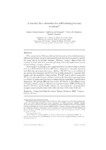Mostrar o rexistro simple do ítem
A succinct data structure for self-indexing ternary relations
| dc.contributor.author | Álvarez García, Sandra | |
| dc.contributor.author | Bernardo, Guillermo de | |
| dc.contributor.author | Brisaboa, Nieves R. | |
| dc.contributor.author | Navarro, Gonzalo | |
| dc.date.accessioned | 2017-02-20T18:31:46Z | |
| dc.date.issued | 2016-10-27 | |
| dc.identifier.citation | Sandra Alvarez-Garcia, Guillermo de Bernardo, Nieves R. Brisaboa, Gonzalo Navarro A succint data structure for self-indexing ternary relations. To appear in Journal of Discrete Algorithms (2016). DOI: 10.1016/j.jda.2016.10.002. | es_ES |
| dc.identifier.issn | 1570-8667 | |
| dc.identifier.issn | 1468-0904 | |
| dc.identifier.uri | http://hdl.handle.net/2183/18148 | |
| dc.description | The final publication is available via http://dx.doi.org/10.1016/j.jda.2016.10.002 | es_ES |
| dc.description.abstract | [Abstract] The representation of binary relations has been intensively studied and many different theoretical and practical representations have been proposed to answer the usual queries in multiple domains. However, ternary relations have not received as much attention, even though many real-world applications require the processing of ternary relations. In this paper we present a new compressed and self-indexed data structure that we call Interleaved K2-tree (IK2-tree), designed to compactly represent and efficiently query general ternary relations. The IK2-tree is an evolution of an existing data structure, the K2-tree [6], initially designed to represent Web graphs and later applied to other domains. The IK2-tree is able to extend the K2-tree to represent a ternary relation, based on the idea of decomposing it into a collection of binary relations but providing indexing capabilities in all the three dimensions. We present different ways to use IK2-tree to model different types of ternary relations using as reference two typical domains: RDF and Temporal Graphs. We also experimentally evaluate our representations comparing them in space usage and performance with other solutions of the state of the art. | es_ES |
| dc.description.sponsorship | Ministerio de Economía y Competitividad; TIN2013-46238-C4-3-R | es_ES |
| dc.description.sponsorship | Xunta de Galicia; GRC2013/053 | es_ES |
| dc.description.sponsorship | Chile. Núcleo Milenio Información y Coordinación en Redes; ICM/FIC RC130003 | es_ES |
| dc.description.sponsorship | Chile.Fondo Nacional de Desarrollo Científico y Tecnológico; 1-140796 | es_ES |
| dc.language.iso | eng | es_ES |
| dc.publisher | Elsevier BV | es_ES |
| dc.relation | info:eu-repo/grantAgreement/EU/H2020/690941 | es_ES |
| dc.relation.uri | http://dx.doi.org/10.1016/j.jda.2016.10.002 | es_ES |
| dc.rights | Atribución-NoComercial-SinDerivadas 3.0 España | es_ES |
| dc.rights.uri | http://creativecommons.org/licenses/by-nc-nd/3.0/es/ | * |
| dc.subject | Compressed data structures | es_ES |
| dc.subject | Ternary relations | es_ES |
| dc.subject | RDF | es_ES |
| dc.subject | Temporal graphs | es_ES |
| dc.subject | K2-tree | es_ES |
| dc.title | A succinct data structure for self-indexing ternary relations | es_ES |
| dc.type | info:eu-repo/semantics/article | es_ES |
| dc.rights.access | info:eu-repo/semantics/embargoedAccess | es_ES |
| dc.date.embargoEndDate | 2018-10-27 | es_ES |
| dc.date.embargoLift | 2018-10-27 | |
| UDC.journalTitle | Journal of Discrete Algorithms | es_ES |
| dc.identifier.doi | 10.1016/j.jda.2016.10.002 |
Ficheiros no ítem
Este ítem aparece na(s) seguinte(s) colección(s)
-
GI-LBD - Artigos [49]
-
OpenAIRE [332]






